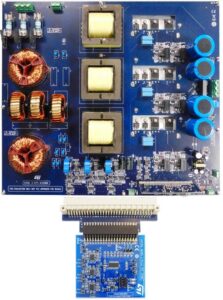Silicon Carbide Webinar: To improve the accessibility of our content, please find the audio version of this blog post.
ST will hold a Silicon Carbide Webinar on September 17 to talk about their use in industrial applications. Rosario Maccarrone, Senior Product Marketing Engineer, and Francesco Gennaro, Power Conversion Application Manager, both from ST, will lead a critical conversation with thought-leaders, decision-makers, and engineers. Indeed, our industry is now quite familiar with SiC and its benefits. Silicon Carbide in Cars is transforming the automotive industry by making electric vehicles more energy efficient. The ST demo car at Electronica China 2020 was a great example of the impact that SiC has on the overall system. However, decision-makers are now wondering if they can replicate the automotive’s success story in other markets, and the truth isn’t always straightforward. The webinar will thus serve as a platform to bring answers and solutions.
It’s a Brand New Silicon Carbide World
Decision-makers must wrestle with the “newness” of Silicon Carbide. The material itself was already available in powder form in the 1890s. However, we are now able to create entirely new transistors, and many wonder about the applications they enable. Managers must, therefore, explain to their hierarchy if SiC makes sense for their operations. The webinar will thus use the example of a power factor correction module. By talking about a PFC and using the STDES-VIENNARECT development board, ST can offer managers practical knowledge from real-life designs. Additionally, to better prepare for the seminar, here are five questions decision-makers should be able to answer to ensure they can better lead their teams and give convincing arguments to their higher-ups.
Silicon Carbide and Industrial Applications
1. Does It Make Sense to Use Silicon Carbide Devices in Industrial Applications?
When determining the viability of new technologies, few things, if any, work as well as a development board. Engineers can use the STDES-VIENNARECT to show how the SCTW35N65G2V SiC power MOSFET benefits industrial applications. Technically, the board is a reference design for a 15 kW three-phase rectifier for power factor correction modules. More broadly, it showcases how to use SiC devices in applications like EV Charging stations, large battery chargers, solar power systems, energy storage systems (ESS), high-end power supplies, and more. This development board is the physical proof that SiC benefits other designs than traction inverters or other auto-grade modules.
Silicon Carbide Webinar objective: equip leaders with tools that expand the scope of SiC devices to industrial applications.
2. When to Use Silicon or Silicon Carbide Devices?

Too often, decision-makers fail to grasp the main challenge behind power factor correction. Making the right technical decisions is thus challenging. What is the main challenge of a PFC module? Duplicating the signal’s sinusoidal shape while preventing harmonic distortions. The best way to achieve such a feat is for engineers to create faster feedback because it introduces fewer errors in the waveform. Hence, a power device with a faster switching frequency is the key to obtaining a better PFC module.
The next step is to determine the switching frequency that will allow Silicon Carbide to shine. The Silicon Carbide Webinar has a slide to tackle this particular question. Indeed, at less than 60 kHz approximately, superjunction transistors offer similar performances. We also held a webinar on insulated gate bipolar transistors in 2019 to help managers understand their role (60 kHz and below). However, between 10 kHz and 1 MHz, Silicon Carbide tends to offer significantly better performance, especially in high-power applications. These are estimates, and it will depend on the application. However, these numbers serve as a guideline. They help see where the industry is heading, and the parameters managers should keep in mind.
Silicon Carbide Webinar objective: Ensure leaders grasp inherent technical challenges and the solutions that will optimize their products.
3. What Are the Benefits of the Higher Switching Frequencies of Silicon Carbide Devices?
Managers may struggle to grasp the concrete benefits of using a Silicon Carbide MOSFET. Indeed, what does a team leader say when asked what a higher switching frequency means to the end-user? The Silicon Carbide Webinar will show benchmarks to ensure managers and engineers come out with actual numbers. For instance, at 40 kHz, using SiC leads to a peak efficiency of 99.2%. On the other hand, an identical design with a similar IGBT device would peak 98.8%. Similarly, at 80 kHz, SiC offers a 0.2 percentage point gain on superjunction MOSFETs. Energy efficiency increases are genuinely hard to get by. An increase of 0.2 and 0.4 percentage points is thus essential, especially when talking about high-power systems.
Such increases in efficiency are also meaningful because they have critical snowball effects. The gains brought on by SiC devices reduce leakage current, and activating the transistor requires less energy. Engineers, therefore, need smaller passive components, and systems tend to run cooler. It is thus possible to make smaller, more cost-effective, and more reliable designs. For instance, switching to SiC can reduce the weight and size of a design by about 30% in some cases.
Silicon Carbide Webinar objective: Provide data points that will help decision-makers understand why the gains brought on by SiC power devices are consequential.
ST’s Silicon Carbide Devices in Industrial Applications
4. Why Should We Care About ST’S Silicon Carbide Devices?
Once teams commit to using SiC devices, leaders must figure out what components they will qualify. People tend to overlook this part of the process. Yet, the decision often has long-lasting repercussions. Traditionally, managers compare datasheets, but these documents can be deceiving. They are usually not identical from one company to the next, and they can get confusing. If decision-makers compare our data sheet with a comparable one from one of our competitors, chances are they will often find similar levels of performance. Numbers don’t lie, but neither do they tell the whole story. Hence, the webinar will take a step back to teach managers the other questions many fail to ask.
For instance, it is crucial to inquire about the manufacturing capabilities of a particular company. Indeed, the impact of a power MOSFET extends far beyond the numbers in its specifications. A company must be able to rely on the front-end and back-end operations of the manufacturer. It’s where ST distinguishes itself as we own every link in that chain. As a result, the same front-end that enabled us to work with major electric car companies is now at the disposal of engineers looking to create designs for industrial applications. Managers can use this reality as a guarantee to the people who will approve their work. Similarly, it’s crucial to know what aspects of production a SiC device maker controls. During this global pandemic, the fact that we manage all the entire chain ensured steady and reliable operations.
Silicon Carbide Webinar objective: Offer inside information and expertise to sharpen decision-making processes and guarantee an optimal outcome.
5. How Does ST’s Second Generation of Silicon Carbide Devices Help Me?
Unlike consumer markets that pride themselves in attracting “early adopters,” industrial applications have a more cautious audience. When asking management to invest in a project, reliability is often a far better metric than novelty. Hence, the fact that we are manufacturing our second generation of SiC devices serves as a reassurance for decision-makers. Our long history with this particular technology and our track record in electric cars are practical arguments one can use to push a design forward. The SCTW35N65G2V present on the STDES-VIENNARECT also shows that the second generation of devices extends the voltage range. Whereas the first generation offered 1,200 V and 1,700V, the latest devices offer 650 V and 1,200 V.
Launching the second generation of devices also means that we could optimize certain aspects of our SiC MOSFETs. For instance, the new power devices have an additional lead for a Kelvin pin. It serves as an absolute ground at the die level to enable faster switching, which reduces losses. Similarly, engineers working on designs that operate in harsh conditions try to determine how a part will behave under stress. We are one of the only manufacturers to certify an operating temperature of 200 ºC. Thanks to our resin packaging, our SiC devices can handle about 25 ºC more than the competition.
